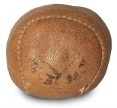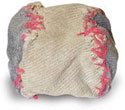When footbag players discuss the original hacky sack they mean one of two things. Sometimes they refer to the first hacky sack that was commercially manufactured and sold as a product. But, typically they will refer to the very first hacky sack ever. In this article, I will expand on both aspects of the original footbag.
Who invented Hacky Sack?
It all begins in the summer of 1972. As the story goes, a guy named Mike Marshall had been locked up in a military brig (jail), and one of the people he was locked up with, an American Indian, introduced him to a new kicking game of a bag filled with beans, a game that would come to be known as “hacky sack”.

Source: worldfootbag
The game consisted of keeping the bag aloft without using their hands. A while later, Mike introduced this activity to his friend John Stalberger at a festival in Oregon. John found the activity to be not only fun but also beneficial for a knee injury he had previously sustained. So, not only hacky sack was (and still is) an activity helpful with rehabilitation, but it was also fun and engaging – the two decided this game should be spread
The bag Mike and John were using is regarded as the “original hacky sack”. And, their footbag would become a crude prototype for many footbags as we know them today.
Hacky sack becoming commercial
According to some sources, the original hacky sacks, or at least the initial prototypes, started out as almost square-shaped and filled with rice, seeds, beans, buttons, and/or whatever else they could find. The shape was basically a square-ish two-panel bag. The bags were made from old clothes, furniture covers, and even leather.

Source: worldfootbag
The old saying “necessity is the mother of invention” is something that can be observed in the story of the original hacky sack and throughout the evolution of the footbag game.
As you can guess, the construction of these first footbags had major design flaws. In 1973, Mike and John began to design a two-panel bag that would be more predictable and consistent when kicked. The two-panel design resembled a baseball. This design made the hacky sack rounder and more ball-like, which proved to be a pivotal move in the early history of hacky sack.
Mike and John would apply for a patent in 1974, but Mike suffered a fatal heart attack at the age of 28. Even though Mike died in ’75, John would continue to develop and manufacture hacky sacks. John would eventually be granted his first patent in ’76.
You can view Mike and John’s first patent here: https://patents.google.com/patent/US3937470A/en?inventor=Robert+J.+Stalberger%2c+Jr.
Their initial patent design consisted of two panels filled with buttons. The panels were sewn together and looked like two thick pancakes stacked on one another. It is filled with flat discs that resemble (or could be) buttons.

Source: worldfootbag
This design does not resemble the footbags we have today, but it does mark hacky sack’s humble beginnings.
After a while, John eventually came to the conclusion that it would be better to fill the baseball patterned two-panel bags with plastic beads. He was granted another patent for this iconic design in ’79. This important change would mark the beginning of the footbag industry, and this industry has obviously evolved a great deal over time.

Source: worldfootbag
You can view Stalberger’s 1979 patent here: https://patents.google.com/patent/US4151994A/en?inventor=Robert+John+Stalberger%2c+Jr.
The footbags of today
Like most good things, we can see how it has evolved over time. At first glance, it doesn’t seem like there is much to a footbag/ hacky sack. It’s some cloth ball stitched together and filled with sand, metal or plastic bids. How complex can that really be?
Footbags were not something to reinvent but rather make improvements to over the years. While the hacky sack rules have stayed more or less consistent over time, the sand footbags and metal hacky sacks we have come to know and love today did not start out with the designs we are familiar with.
Today’s hacky sacks are a result of trial and error. They are the result of players identifying and correcting problems they encountered. Refinement has produced a market of great footbags that are available at a few clicks of a button.
Where can you buy the original hacky sack?
Kicking games are not new. There are records of people and cultures developing and engaging in kicking games for millennia. Games similar to shuttlecock, sepak takraw, and some form of football/soccer have been recorded throughout cultures around the world for millennia.
If you are so inclined to purchase these historically significant footbags, a quick Google search will provide a list of websites that offer vintage hacky sacks. I’ve done most of the legwork for you and compiled a list of websites where you can purchase many of the earliest manufactured hacky sacks. If you are looking for “vintage hacky sacks”, then these websites are probably your best bet.
- Original hacky sack on E-bay
- picclick.com
- worldfootbag.com – Hacky sack footbag original
- worldfootbag.com – Collectors footbags
The original hacky sack from the late 70’s is difficult to find. From what I’ve observed, you will have to pay a premium for footbags from the late 1970’s. There are many vintage hacky sacks from the 80’s and 90’s available, it just depends on how much you want to pay for one.
Why buy an original footbag?
The reasons to purchase an original hacky sack are not based on performance or bettering your skills as a player necessarily, but rather so that you can own a piece of footbag history. If fact, it is probably not a good idea to kick a bag that is 30 to 40 years old.
From my perspective, having something akin to the original hacky sack in your collection is a cool novelty, and it can also connect you to the history of footbag. In a sense, it is a talisman of the sport. It signifies the simple beginnings of something that has grown in to a cultural phenomenon.
In today’s world, SandMaster footbags and metal hack sacks are ideal hacky sacks for beginners and pulling off hacky sack tricks. These contemporary footbags have an ever-growing lineage that stems back to simple beginnings.
So, the next time you are out kicking the bag by yourself or with friends in a circle, be sure to take a second to appreciate the time and effort that has gone in to developing this amazing sport we know as footbag.
[Pictures of early footbags: http://worldfootbag.com/about-footbag/]
Read Next
- Hacky Sack – How it all began and where is it now 2019
- 5 Best Footbags For Beginners
- 6 Basic Hacky Sack Rules (Explained By a Real Player)
- My SandMaster Footbag Review After Playing With It For Years
- What Are The Benefits Of Hacky Sack Game Playing?
- What Is In A Hacky Sack? All Filling Materials Reviewed